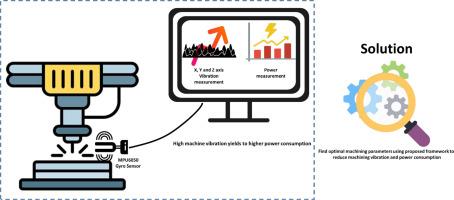通过参数优化,最大限度地减少AZ31合金铣削过程中的振动和功耗
IF 7.9
Q1 ENGINEERING, MULTIDISCIPLINARY
引用次数: 0
摘要
提出了AZ31镁合金铣削过程中振动和功耗最小化的集成优化框架。采用田口L25正交试验,研究了主轴转速、进给速度和切削深度对加工精度的影响。实时数据采集捕获沿X、Y和Z轴的振动,以及功耗。采用Pearson相关分析建立逐步回归模型,发现主轴转速是影响最大的参数。将这些模型输入到NSGA-II算法中,生成最优解的Pareto前。最佳理论解预测振动幅值为−8.2 mm (X), 7.7 mm (Y), 4.2 mm (Z),功耗为68.13 W。实验验证产生的误差为4% (X), 4% (Y), 10% (Z)和- 6%(功率),证实了模型的准确性。相关分析表明,主轴转速对能耗和z轴振动的影响最大(r = 0.45和r = 0.16),切削深度对x轴和y轴振动的影响显著(r = 0.27和r = 0.15)。本文章由计算机程序翻译,如有差异,请以英文原文为准。

Minimizing vibrations and power consumption in milling of AZ31 alloy through parameter optimization
This study presents an integrated optimization framework for minimizing vibration and power consumption during the milling of AZ31 magnesium alloy. A total of 25 experiments were performed using a Taguchi L25 orthogonal array to investigate the influence of spindle speed, feed rate, and depth of cut. Real-time data acquisition captured vibrations along the X, Y, and Z axes, as well as power consumption. Stepwise regression models were developed using Pearson’s correlation analysis, revealing spindle speed as the most influential parameter. These models were input into the NSGA-II algorithm, generating a Pareto front of optimal solutions. The best theoretical solution predicted vibration amplitudes of −8.2 mm (X), 7.7 mm (Y), 4.2 mm (Z), and a power consumption of 68.13 W. Experimental validation yielded errors of 4 % (X), 4 % (Y), 10 % (Z), and −6 % (power), confirming the model's accuracy. Correlation analysis indicated that spindle speed had the greatest influence on power consumption and Z-axis vibrations (r = 0.45 and r = 0.16), depth of cut significantly affected X-axis and Y-axis vibrations (r = 0.27 and r = 0.15) The framework effectively improves machining sustainability by optimizing process parameters.
求助全文
通过发布文献求助,成功后即可免费获取论文全文。
去求助
来源期刊

Results in Engineering
Engineering-Engineering (all)
CiteScore
5.80
自引率
34.00%
发文量
441
审稿时长
47 days
 求助内容:
求助内容: 应助结果提醒方式:
应助结果提醒方式:


